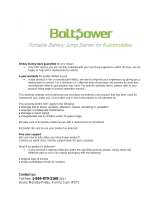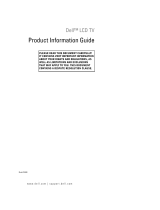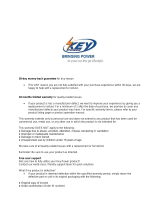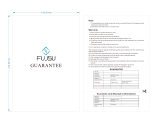Page is loading ...

Dell™ 2405FPW Flat Panel Monitor
About Your Monitor
Front View
Back View
Side View
Bottom View
Monitor Specifications
Universal Serial Bus(USB) Interface
Card Reader Specifications
Dell™ Sound Bar (Optional) Specifications
Caring for Your Monitor
Using Your Adjustable Monitor Stand
Attaching the Stand
Organizing Your Cables
Using the Tilt, Swivel, Vertical Extension
Removing the Stand
Setting Up Your Monitor
Connecting Your Monitor
Using the Front Panel Buttons
Using the OSD
Setting the Optimal Resolution
Using the Dell™ Sound Bar (Optional)
Using the Card Reader
Rotating Your Monitor
Changing the Rotation of Your Monitor
Rotating Your Operating System
Solving Problems
Monitor Specific Troubleshooting
Common Problems
Video Problems
Product Specific Problems
Universal Serial Bus (USB) Specific Problems
Dell™ Sound Bar (Optional) Troubleshooting
Card Reader Troubleshooting
Appendix
Warranty Information
Safety Information
Safety Information: Card Reader
Contacting Dell™
Regulatory Notices
Your Monitor Set-up Guide
Notes, Notices, and Cautions
Throughout this guide, blocks of text may be accompanied by an icon and printed in bold type or in italic type. These
blocks are notes, notices, and cautions, and they are used as follows:
NOTE: A NOTE indicates important information that helps you make better use of your computer.
NOTICE: A NOTICE indicates either potential damage to hardware or loss of data and tells you how to avoid the
problem.
CAUTION: A CAUTION indicates the potential for property damage, personal injury, or death.
Some warnings may appear in alternate formats and may be unaccompanied by an icon. In such cases, the specific
presentation of the caution is mandated by regulatory authority.
Information in this document is subject to change without notice.
© 2005 Dell™ Inc. All rights reserved.
Reproduction in any manner whatsoever without the written permission of Dell Inc. is strictly forbidden.
Trademarks used in this text: Dell, the DELL logo, Inspiron, Dell Precision, Dimension, OptiPlex, Latitude, PowerEdge, PowerVault, PowerApp,
and Dell OpenManage are trademarks of DellInc; Microsoft and Windows are registered trademarks of Microsoft Corporation; ENERGY STAR is
a registered trademark of the U.S. Environmental Protection Agency. As an ENERGY STAR partner, Dell Inc. has determined that this product
meets the ENERGY STAR guidelines for energy efficiency. CompactFlash is a trademark of The CompactFlash Association (CFA). Secure Digital is
a trademark of The Secure Digital Association. SmartMedia is a trademark of Toshiba Corporation. MultiMediaCard is a trademark of
MultiMediaCard Association. Microdrive is a trademark of International Business Machines Corporation. Memory Stick and MagicGate are
trademarks of Sony Corporation.
Other trademarks and trade names may be used in this document to refer to either the entities claiming the marks and names or their
products. Dell Inc. disclaims any proprietary interest in trademarks and trade names other than its own.
April 2005 Rev. A01

Back to Contents Page
About Your Monitor
Dell™ 2405FPW Flat Panel Monitor
Front View
Back View
Side View
Bottom View
Monitor Specifications
Universal Serial Bus(USB) Interface
Card Reader Specifications
Dell™ Sound Bar (Optional) Specifications
Caring for Your Monitor
Front View
1 Input indicators
2 Input selection
3 PIP (Picture In Picture) / PBP (Picture By Picture) selection
4 Menu selection
5 Brightness & Contrast / Down(-)
6 Auto-Adjust / Up(+)
7 Power button
Back View

1 Kensington lock slot
2 USB downstream ports and card reader
3 Mechanical attachment point for Dell™ Sound Bar
4 Cable holder
5 Stand lock release button
Side View
Right side

Left side
1 Card reader: for details please refer to
Card Reader Specifications
2 USB downstream ports
3 Display removal button
Bottom View
1 AC power cord connector
2 DC power connector for Dell™ Sound Bar
3 S-Video connector
4 Composite video connector
5 Component video connectors
6 DVI connector
7 VGA connector
8 USB upstream port
9 USB downstream ports

Monitor Specifications
General
Model number 2405FPW
Flat Panel
Screen type Active matrix - TFT LCD
Screen dimensions 24 inches (24-inch diagonal viewable image size)
Preset display area:
Horizontal 518.4 mm (20.4 inches)
Vertical 324.0 mm (12.7 inches)
Pixel pitch 0.270 mm
Viewing angle +/- 89° (vertical) typ, +/- 89° (horizontal) typ
Luminance output 500 cd/m ²(typ)
Contrast ratio 1000:1 (typ)
Faceplate coating Antiglare with hard-coating 3H
Backlight 6 CCFLs U-type backlight
Response Time 12ms typical (Grey to Grey) / 16ms typical (Black to White)
Resolution
Horizontal scan range 30 kHz to 81 kHz (automatic)
Vertical scan range 56 Hz to 76 Hz, exception 1680 x 1200 & 1920 x 1200 at 60 Hz
only
Optimal preset resolution Analog : 1920 x 1200 at 60 Hz(VESA CVT-R Mode)
Digital : 1920 x 1200 at 60 Hz(VESA CVT-R Mode)
Highest preset resolution Analog : 1920 x 1200 at 60 Hz(VESA CVT-R Mode)
Digital : 1920 x 1200 at 60 Hz(VESA CVT-R Mode)
Dell™ guarantees image size and centering for all preset modes listed in the following table.
Preset Display Modes
Display Mode Horizontal Frequency (kHz) Vertical Frequency (Hz) Pixel Clock (MHz) Sync Polarity (Horizontal/Vertical)

VGA, 720 x 400 31.5 70.1 28.3 -/+
VGA, 640 x 480 31.5 59.9 25.2 -/-
VESA, 640 x 480 37.5 75.0 31.5 -/-
VESA, 800 x 600 37.9 60.3 40.0 +/+
VESA, 800 x 600 46.9 75.0 49.5 +/+
VESA, 1024 x 768 48.4 60.0 65.0 -/-
VESA, 1024 x 768 60.0 75.0 78.8 +/+
VESA, 1152 x 864 67.5 75.0 108.0 +/+
VESA, 1280 x 1024 64.0 60.0 108.0 +/+
VESA, 1280 x 1024 80.0 75.0 135.0 +/+
VESA, 1600 x 1200
75.0 60.0 162.0
+/+
VESA, 1920 x 1200
74.0 60.0 154.0
+/-
Electrical
Video input signals Analog RGB: 0.7 Volts +/-5%, 75 ohm input impedance
Digital DVI-D TMDS: 600mV for each differential line, 50 ohm
input impedance
S-video: Y input 1 volt(p-p), C input 0.286 volt(p-p), 75 ohm
input impedance
Composite: 1 volt(p-p), 75 ohm input impedance,
Component: Y, Pb, Pr are all 0.5~1volt(p-p), 75 ohm input
impedance
Synchronization input signals separate horizontal and vertical,
3.3V Cmos or 5V TTL level, positive or negative sync.
SOG (Sync on green)
AC input voltage / frequency / current 100 to 240 VAC / 50 or 60 Hz
+ 3 Hz / 2.0A (Max.)
Inrush current 120V: 40A (Max.)
240V: 80A (Max.)
Physical Characteristics
Signal cable type D-sub: Detachable, Analog, 15pin, shipped attached to the
monitor
DVI-D: Detachable, Digital, 24pin, shipped detached from the
monitor
S-video: Not included with display
Composite: Not included with display
Component: Not included with display
Dimensions (with stand):
Height (fully extended in portrait mode) 642.7 mm (25.3 inches)
Height (compressed/locked in landscape mode) 546.8 mm (21.5 inches)
Width 559.4 mm (22.0 inches)
Depth 229.0 mm (9.0 inches)
Weight
Monitor (Stand and Head) 10.0 kg (22.1 lb)
Monitor Flat panel only (VESA Mode) 7.0 kg (15.4 lb)
Weight with packaging 13.2 kg (29.1 lb)
Environmental
Temperature:
Operating 5° to 35°C (41° to 95°F)
Nonoperating Storage: 0° to 60°C (32° to 140°F)
Shipping: -20° to 60°C(-4° to 140°F)

Humidity:
Operating 10% to 80% (noncondensing)
Nonoperating Storage: 5% to 90% (noncondensing)
Shipping: 5% to 90%(noncondensing)
Altitude:
Operating 3,657.6 m (12,000 ft) max
Nonoperating 12,192 m (40,000 ft) max
Thermal dissipation 272.8 BTU/hour (maximum)
201.2 BTU/hour (typical)
Power Management Modes
If you have VESA's DPMS compliance display card or software installed in your PC, the monitor can automatically reduce its power consumption when not in
use. This is referred to as 'Power Save Mode'*. If input from keyboard, mouse or other input devices is detected by the computer, the monitor will
automatically "wake up". The following table shows the power consumption and signaling of this automatic power saving feature:
VESA Modes Horizontal Sync Vertical Sync Video Power Indicator Power Consumption
Normal
operation
Active Active Active Green 80 W (maximum)*
59 W (normal)**
Active-off mode Inactive Inactive Blanked Amber Less than 2 W
Switch off - - - Off Less than 1 W
* With Audio + USB
** Without Audio + USB
NOTE: The OSD will only function in the 'normal operation' mode. Otherwise one of the following messages will appear
depending upon the selected input.
1: D-SUB
In Power Save Mode
Press computer power button
or any key on keyboard or move mouse
or
2: DVI-D
In Power Save Mode
Press computer power button
or any key on keyboard or move mouse
Activate the computer and wake up the monitor to gain access to the
OSD.
Pin Assignments
VGA Connector
Pin Number 15-pin Side of the Connected Signal Cable
1 Video-Red
2 Video-Green
3 Video-Blue
4 GND
5 Self-test
6 GND-R
7 GND-G
8 GND-B
9
Computer 5V/3.3V
10 GND-sync
11 GND

12 DDC data
13 H-sync
14 V-sync
15 DDC clock
DVI Connector
Pin Number 24-pin Side of the Connected Signal Cable
1 TMDS RX2-
2 TMDS RX2+
3 TMDS Ground
4 Floating
5 Floating
6 DDC Clock
7 DDC Data
8 Floating
9 TMDS RX1-
10 TMDS RX1+
11 TMDS Ground
12 Floating
13 Floating
14
+5V / +3.3V power
15 Self test
16 Hot Plug Detect
17 TMDS RX0-
18 TMDS RX0+
19 TMDS Ground
20 Floating
21 Floating
22 TMDS Ground
23 TMDS Clock+
24 TMDS Clock-
S-video Connector

Pin Number 5-pin Side of the Connected Signal Cable (Cable not included)
1 GND
2 GND
3 LUMA
4 CHROMA
5 GND
Composite Video Connector
Pin Number 1-pin Side of the Connected Signal Cable (cable not included)
1 LUMA COMPOSITE CHROMA
Component Video Connector
Pin Number 3-pin Side of the Connected Signal Cable (Cable not
included)
1
Y (Luminance signal)
2
Pb (Color differential signal)
3
Pr (Color differential signal)
Universal Serial Bus (USB) Interface
This monitor supports High-Speed Certified USB 2.0 interface.
Data Rate Power Consumption
High speed 480 Mbps 2.5W (Max., each port)
Full speed 12 Mbps 2.5W (Max., each port)
Low speed 1.5 Mbps 2.5W (Max., each port)
USB Upstream Connector

Pin Number 4-pin Side of the connector
1 DMU
2
VCC
3 DPU
4 GND
USB Downstream Connector
Pin Number 4-Pin Side of the Signal Cable
1 VCC
2 DMD
3 DPD
4 GND
USB Ports
1 upstream - rear
4 downstream - 2 on rear; 2 on right side
NOTE: USB 2.0 capability requires 2.0-capable computer
NOTE: The monitor's USB interface works only when the monitor is on or in power save mode, If you switch the monitor off and then on,
attached peripherals may take a few seconds to resume normal functionality.
Card Reader Specifications
Overview
The Flash Memory Card Reader is a USB storage device that allows users to read and write information from and into the memory card.
The Flash Memory Card Reader is automatically recognized by Windows® 2000 and XP.
Once installed and recognized, each separate memory card (slot) appears as a separate drive/drive letter.
All standard file operations (copy, delete, drag-and-drop, etc.) can be performed with this drive.
Features
The Flash Memory Card Reader has the following features:
Supports Windows 2000 and XP operating systems

No Windows 9X support from Dell
Mass Storage Class device (No drivers are required under Windows 2000 and XP)
USB-IF certification
Supports various memory card media
Slot Number Flash memory cards type
1
CompactFlash type I/II Card (CF I/II)/ MicroDrive (MD)
2
SmartMedia Card (SMC)
3 Memory Stick Card (MS) ./ Memory Stick Pro Card (MS PRO) / Memory Stick Duo (with Adapter)
4
Secure Digital Card (SD)/ MultiMediaCard (MMC)/ Mini Secure Digital (with Adapter)
General
Connection type USB 2.0 High Speed Device (USB Full Speed Device compatible)
Supported OS Windows 2000 and XP
Performance
Transfer Speed Read: 480 Mb/s (max.)
Write: 480 Mb/s (max.)
Dell™Sound Bar (Optional) Specifications
System Frequency Response 95 Hz to 20 kHz @ 10 dB below avg. SPL
Total Power Output 14 W continuous average power (all speakers operating) @ 10% (THD+N), 1 kHz (FTC rated)
Headphone Jack
Output Power
40 mW continuous average power (RL = 32Ω) @ 10% (THD+N), 1 kHz
Input Sensitivity for
Rated Output
500 ± 50 mVrms @ 1 kHz
Input Impedance >10kΩ
Maximum Input Signal
Voltage
2 Vrms
Controls Power On/Off Volume Control
Input Cables 3.0 m ± 0.1 m AWG26 black cable attached to enclosure, with 3.5 mm lime green stereo plug
Power Requirements DC12V, 1.5A +/-10%

Power Cord Length 305 mm ± 15 mm AWG22 black cable attached to enclosure, with DC plug (5.5 x 2.1 x 12 mm)
Operating Temperature Range 10°C to 40°C
Humidity, Non-condensing 95% RH @ 40 °C
Plug and Play Capability
You can install the monitor in any Plug and Play-compatible system. The monitor automatically provides the computer system with its Extended Display
Identification Data (EDID) using Display Data Channel (DDC) protocols so the system can configure itself and optimize the monitor settings. If desired, the
user can select different settings, but in most cases monitor installation is automatic.
Caring for Your Monitor
CAUTION: Read and follow the Safety Information before cleaning the monitor.
CAUTION: Before cleaning the monitor, unplug the monitor from the electrical outlet.
To clean your antistatic screen, lightly dampen a soft, clean cloth with water. If possible, use a special screen-cleaning tissue or solution suitable for
the antistatic coating. Do not use benzene, thinner, ammonia, abrasive cleaners, or compressed air.
Use a lightly-dampened, warm cloth to clean the plastics. Avoid using detergent of any kind as some detergents leave a milky film on the plastics.
If you notice a white powder when you unpack your monitor, wipe it off with a cloth. This white powder occurs during the shipping of the monitor.
Handle your monitor with care as darker-colored plastics may scratch and show white scuff marks more than lighter-colored monitor.
Back to Contents Page

Back to Contents Page
Using Your Adjustable Monitor Stand
Dell™ 2405FPW Flat Panel Monitor
Attaching the Stand
Organizing Your Cables
Using the Tilt, Swivel, Vertical Extension
Removing the Stand
Attaching the Stand
1. Place the stand on a flat surface.
2. Fit the groove on the back of the monitor onto the three teeth of upper stand.
3. Lower the monitor so that the monitor mounting area snaps on/locks to stand.
Organizing Your Cables

After attaching all necessary cables to your monitor and computer, (See Connecting Your Monitor for cable
attachment,) use the cable holder to neatly organize all cables as shown above.
Using the Tilt, Swivel and Vertical Extension
Tilt/Swivel
With the built-in pedestal, you can tilt and/or swivel the monitor for the most comfortable viewing angle.
NOTE: Stand is detached and extended when the monitor is shipped from the factory.
Vertical Extension
Stand extends vertically up to 100mm via the stand lock release button.

NOTE: If locked in the down position, press the stand lock release button on the bottom rear of stand. Lift the front
panel up and extend the stand to the desired height.
NOTICE: Before relocating/moving the monitor to a different location, make sure that the stand is LOCKED DOWN.
To lock it down, lower the height of the panel until it clicks and is locked into place.
Removing the Stand
After placing the monitor panel on a soft cloth or cushion, press and hold the LCD removal button, and then remove the

stand.
NOTE: To prevent scratches on the LCD screen while removing the stand, ensure that the monitor is placed on a
clean surface.
Back to Contents Page

Back to Contents Page
Setting Up Your Monitor
Dell™ 2405FPW Flat Panel Monitor
Connecting Your Monitor
Using the Front Panel Buttons
Using the OSD
Using the Dell™ Sound Bar (Optional)
Using the Card Reader
Connecting Your Monitor
CAUTION: Before you begin any of the procedures in this section, follow the Safety Information.
1 Power cord connector
2 DC power connector for Dell™ Sound Bar
3 S-Video connector (cable not included)
4 Composite video connector (cable not included)
5 Component video (Y Pb Pr) connectors (cable not included)

6 DVI connector
7 VGA connector
8 USB upstream port
9 USB downstream ports
Turn off your computer and disconnect the power cable.
Connect either the white (digital DVI-D) or the blue (analog D-sub) display connector cable to the corresponding video port on the back of your computer. Do not use both cables on the same computer. The
only case in which both cables can be used is if they are connected to two different computers with appropriate video systems. (Graphics are for illustration only. System appearance may vary).
Connect the upstream USB port (cable supplied) to an appropriate USB port on your computer .
Connect USB peripherals to the downstream USB ports (rear or side) on the monitor. (See rear or bottom view for details.)
Connect the DC power cable for your monitor to the power port on the back of the monitor.
Plug the power cables for your computer and monitor into a nearby outlet.
Turn on the monitor and computer.
If your monitor displays an image, installation is complete. If it does not display an image, see
Solving Problems.
Use the cable holder on the monitor stand to neatly organize the cables.
NOTE: If your computer does not support the DVI connector, you can leave the cable unconnected or remove it.
NOTE: For USB peripherals already connected to your computer, changing the USB connection to your monitor is not necessary.
Using the Front Panel Buttons
Use the control buttons on the front of the monitor to adjust the characteristics of the image being displayed. As you use these buttons to adjust the controls, an OSD shows their numeric values as they change.
A
Input select
Use Input Select button to select between five different video signals that may be connected to your monitor.
1. VGA input
2. DVI-D input
3. S- Video input
4. Composite video input
5. Component video (Y Pb Pr) input
NOTE: VGA is referred to as D-SUB in the OSD
NOTE: The floating 'Dell™ - self-test Feature Check' dialog will also appear on-screen (against a black background) if the
monitor cannot sense a video signal. Depending upon the selected input, one of the dialogs shown below will scroll
continually.
NOTE: Self test feature check is not available for S-Video, Composite video and Component video (Y Pb Pr) modes.
NOTE: If VGA/DVI-D cable is unconnected, monitor automatically looks for VGA/DVI-D connection and indicates the "Self
Test Feature Check" pattern on the screen for the disconnected port that was last used.

or
If it finds a cable connection with the computer, then it looks for activated VGA/DVI-D port on the computer and makes the
selection for that port.
NOTE: If S-video/Composite video /Component video (Y Pb Pr) cable is not connected or the video source is turned off, the
screen will be turned off, when any button except power button is pressed. The monitor displays "No Input Signal" for the
corresponding connection .
B
PIP/PBP Select
PIP Settings:
Use this button to activate PIP (Picture-in-Picture)/PBP (Picture-by-Picture) mode adjustment.
Pressing this button continually will cycle the sub-screen through the PIP -> PBP -> OFF (Original state without sub-screen) modes
with the corresponding brief OSD menu.
Pressing PIP/PBP for the first time in sequence (PIP) will open "PIP Setting" Menu.
The details of the menu is as follows:
- PIP Source : To select an input signal for PIP. (VGA/DVI/S-video/Composite/Component)
Use
and to choose and to select.
- Swap : To switch the main-screen and sub-screen in PIP mode.
Use
and to choose and to select.

PBP Settings:
- PIP size : To adjust the size of the PIP screen between "Small","Medium", and "Large".
Use
and to choose and to select.
- Position : Move the PIP window.
Use
and to choose and to select.
- Advanced Menu : To adjust the detail menu of PIP Setting. See
PIP/PBP Settings.
Use
to select.
Pressing PIP/PBP
for the second time in sequence(PIP->PBP) will open "PBP Settings" Menu.
The details of the menu is as follows:
- PBP Source : To select an input signal for PBP. (VGA/DVI/Svideo/Composite/Component)
Use
and to choose and to select. The PBP active sub-screen is shown with "blue border" beside the main-screen on
the right hand side.
- Swap : To switch the main-screen and sub-screen in PBP mode.
Use
and to choose and to select.
- Advanced Menu : To adjust the detail menu of PIP Setting. See
PIP/PBP Settings.
Use
to select.
C
OSD menu & select
The MENU button is used to open the on-screen display(OSD) and select the OSD Menu. See
Accessing the Menu System.
D,
E
Minus (- ) and Plus (+)
Use these buttons for navigating and adjusting the slider-bar(decrease/increase ranges) controls in the OSD.
D Use this button to activate Brightness/Contrast adjustment.
With the Menu off, push the
button to display the Brightness/Contrast adjustment menu.
/



